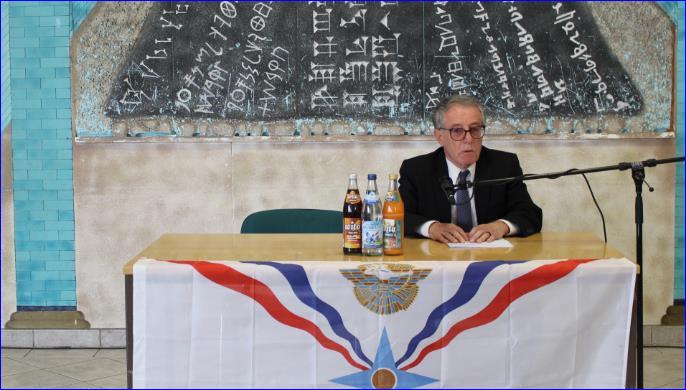


From their grandparents who survived the genocide, the Assyrians know well the repeated saying: what happened to us did not happen to any people."
Mr. BarAbraham made clear at the beginning of his speech that he would not participate in the debate of the comparison of the planning, organization or implementation of the two genocides - or even the comparison of the casualties.
In fact, in the context of comparative genocide studies many research papers and publications have been produced comparing the genocide of 1915 with the Holocaust. During the latter six millions Jews were killed. The genocide of 1915 is seen as the first genocide in the 20th century; about 2.5 million Assyrians, Armenians and Pontic Greeks fell victim. At a commemorative event on April 2015, the German Bundestag for the first time described the events of 1915 as "genocide" (völkermord) (AINA 2016-06-06). An all-party resolution was passed in June 2016 by the German Parliament which explicitly mentions Assyrians (known also as Chaldeans and Syriacs) as co-victims of Armenians. In Germany, the public TV stations every other week show a documentary about the Nazi rule. Again and again the 'uniqueness' of the Holocaust is highlighted.
Related: The Assyrian Genocide
'Singularity' or 'uniqueness' refers to particular historical characteristics that distinguish the Holocaust from all other genocides and mass murders in history. In context of the planning of the Holocaust Memorial Museum in Washington in the United States in 1978, a dispute emerged over the definition of the Holocaust concept. Representatives of non-Jewish victim groups also wanted to see their persecution in the Nazi era as part of the Holocaust incorporated into the concept of the Museum. In the following debate and research, most Holocaust researchers emphasized the singularity of the Holocaust in terms of real and targeted casualties, state planning, and its systematic and industrial implementation. Some of their special investigations into the genesis, planning and conduct of other genocides have confirmed the basic assumption of most of the researchers with regards of 'uniqueness' of the Holocaust.
Some historians argue that even Adolf Hitler took the genocide of the Armenians as an example to realize his final solution of the Jews. Because he believed that the Endlösung (Final Solution) he planned would eventually fall into oblivion. From him is the saying handed down, where on August 22, 1939 shortly before the invasion of Poland, at Obersalzberg he asked,: "Who, after all, speaks today of the annihilation of the Armenians?"1
"From the point of view of the Assyrians and their genocide, the differences between the two genocides could not be greater," stressed Mr. BarAbraham. At the time of the genocides, the victims lived in different social, political and cultural situations as well as in different geographic regions.
In contrast to the Jews, who lived in the European Diaspora for centuries, the Assyrians lived for thousands of years in their native home region of Mesopotamia as an indigenous population, until 1915. Not only that, "they lived in cities and towns, some of which they had founded centuries before. But as Christians, they lived in the Ottoman Empire as second class citizens, isolated, suppressed, as so-called Dhimmi, which in Arabic means 'ordered for protection.'" Therefore, and as non-Muslims, they had to pay Jizya, a poll tax, which was imposed under Islamic rule. In the years 1894-96 Assyrians became victims of systematic massacres in the Ottoman Empire.
Related: Genocides Against the Assyrian Nation
Mr. BarAbraham elaborated on the Assyrian genocide as a traumatic and unique experience for the survivors. Such a trauma inevitably becomes part of the collective psyche of an affected nation, spanning generations. This is called transgenerational transmission, inherited suffering or trauma between generations. Even the grandchildren of those affected by mass murder can suffer from mental disorders. The trauma for the victims is not only extraordinary, but also defies comparison.
It is no coincidence that Assyrian churches today call themselves "churches of the martyrs". The historical traces of the persecution as Christians extend from the times of Roman rule, over the reign of King Shapur II in the Persian Empire to the Ottoman Empire and Islamic State in recent times.
A Vatican meeting in June 2015 between Pope Francis and Mor Ignatius Aphrem II, the Syrian Orthodox Patriarch, focused on "The Blood of the Martyrs" as the "Seed of the Unity of the Church." Pope Francis said: "Yours, Beatitude, has been a Church of martyrs since the very beginning, and continues to be so to this day in the Middle East, where, along with other Christian communities and other minorities, it suffers greatly as a result of war, violence and persecution. How much pain! How many innocent victims!"
Commenting on the repetition of genocide in the wake of the emergence of Islamic State in Syria and Iraq one hundred years after the Turkish genocide, Mr. BarAbraham concluded "the history of the Assyrians testifies to extraordinary experiences" and "one can observe that in the case of the Assyrians and over the history the experience of the persecution is not entirely coincidental." Due to these experiences, it is only natural that Assyrians developed a self-image of uniqueness.
1 Travis, Hannibal. Did the Armenian Genocide Inspire Hitler? Turkey, Past and Future. Middle East Quarterly. Winter 2013, pp. 27-35.
Abdulmesih BarAbraham is an independent researcher on Assyrian related topics; he has published various articles. He is author of "Turkey's Key Arguments in Denying the Assyrian Genocide," in David Gaunt et. al. (Eds.), Let Them Not Return (New York: Berghahn Books, 2017); and "Sayfo 1915 - What did Germany know?" in Shabo Talay and Soner Barthoma (Eds.), Sayfo 1915: Anthology of Essays on the Genocide of Assyrians / Arameans During the First World War. (Piscayaway: Gorgias Press, 2018). Abdulmesih is the Chairman of the Board of Trustees of both, the Yoken bar-Yoken Foundation and Mor Afrem Foundation, Germany.

or register to post a comment.